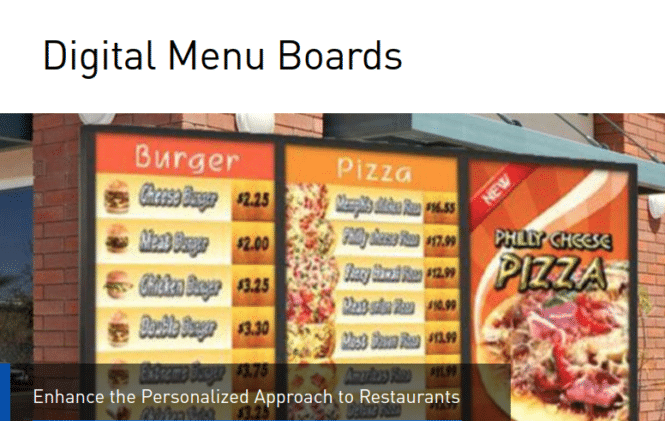
From Samsung July 2021 —
Amid shifting consumer habits and disrupted supply chains, digital signage has been critical in helping restaurant operators adapt their businesses. Drive-thrus were already a common feature of quick service restaurant (QSR) chains, but in light of the pandemic, drive-thrus have come to represent as much as 100 percent of QSR sales.
Where drive-thrus aren’t feasible, such as in urban areas, operators have found new ways to stay open, like allowing customers to order ahead for pickup in the lobby. These changes have created new ways to serve customers — and these changes are likely to stick around.
Shifting from static to digital
My job has me talking almost all day, every day with America’s restaurant operators and the companies that service them. In 2020, I saw a huge shift toward digital displays to address the business challenges introduced by COVID-19.
When operators evolve from static, printed poster material to digital menus and promotions, they gain incredible flexibility. Updates take minutes — not days or weeks. Digital menus pay their way by influencing ordering decisions and removing the printing, shipping and labor costs of printed signs and posters.
Modernize your QSR with digital displays
Explore how digital signage is improving customer experiences and motivating QSR employees Download Now
We’ve seen a huge uptick of customers and prospects coming to us, wanting to revisit and accelerate discussions about going digital. They’ve watched larger brands who had already adopted digital easily adjust and manage their way through the pandemic. They’ve seen operators quickly revise their menus based on availability and communicate their new business practices effectively.
All of a sudden, they were asking us, “So, how can we get digital installed at our stores immediately?” They were looking for guidance on how to organize, manage and create effective messaging and fully integrate digital solutions into their operations.
Putting screens to work
So how does this look in the field? Digital menu boards in drive-thrus have seen a dramatic rise in popularity, with global QSR operators like McDonald’s installing these boards across their entire national footprint. Competitors of all sizes have followed suit.
Outdoor digital displays are bright enough to handle the sun’s glare and tough enough to handle its heat. These displays presell items to customers as they approach the ordering position, showing them only the dining options that are currently available. McDonald’s is optimizing ordering opportunities by using AI technology and anonymous customer data to dynamically alter menus vehicle by vehicle.
Beyond drive-thru menus, outdoor signage also offers an effective, hard-to-miss way to communicate logistical business changes, such as operating hours, dining room access or other topical messaging.
Inside the restaurant, self-service kiosks allow patrons to forgo long lines and face-to-face interactions. Kiosks can also increase revenue with opportunities to upsell customers and offer easy signup for loyalty programs. The new Samsung Kiosk is a ready-out-the-box solution that can enhance the customer journey and optimize operational efficiency.
Delivering safe, efficient food service
Delivery has been a savior for operators without drive-thrus. Ordering ahead has also grown much more popular, with operators keeping their staff and customers safe by offering curbside pickup.
Outdoor-ready screens and super-bright window displays — visible from the parking lot — act as beacons that guide diners where they need to go. Tied to your brand’s online ordering platform, the supporting software drives messaging to the screens, letting motorists know their order status.
Multiple app-driven delivery services are used to fulfill remote orders. In meal preparation areas, we’re seeing more kitchen display systems used to dynamically track orders and drivers.
Window displays also drive awareness of order-ahead options. Many operators have installed Samsung’s unique double-sided displays. The outward-facing screen handles ordering, while the inward-facing screen promotes special offers and helps recruit new team members.
Integrated with a content management system (CMS), outward-facing screens let diners know if they should stay in their car or come inside to pick up their order. These notifications can also be pushed to customers’ smartphone apps, but many order-ahead systems are online, not tied to any apps.
Communicating with passersby
At restaurant locations that focus on walk-up ordering, we’ve seen increased adoption of portable displays that draw in passersby on foot.
These displays are an upgrade from sidewalk sandwich boards and poster totems featuring daily specials or calls to action. In the past, a single message might have been enough to attract diners. Now, operators have multiple messages they need to convey, and with restricted capacity, they need to work even harder to realize an operating profit. At the simplest level, a bright display outside a venue can make it known to diners that the place is open for business, patrons are welcome and the eating environment is cleaned, sanitized and safe.
Managing business changes
With a CMS like Samsung’s MagicINFO 9, owners and operators get a complete view and full control of their display content, both inside and outside. Their display toolset can be operated from an on-site PC, or managers can control messaging from a distant office, or even from home. Operators can use Multi Screen remote control to quickly perform device health checks and diagnose issues, then turn as many as 12 devices on or off at once, directly from the server.
Digital displays have become central to how QSRs do business, and in 2021, their benefits are becoming even more evident.
Learn more about the revenue opportunities that QSRs can realize with digital signage and content management in this free guide. Or, discover additional signage solutions Samsung has created to help QSRs and other industries get back to business while keeping staff and customers safe.